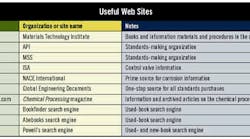It's a jungle out there," as the saying goes. Unfortunately, that jungle can extend to and include your work environment. And if you are responsible for some part of a chemical processing facility, the vines and beasts of that jungle can wrap around and through the pipe racks, instrument panels and valves you call home every workday.
If this sounds familiar to you, then you probably will not turn down a little survival help.
As an engineer or technician you probably have to deal with valves everyday. Depending on your job description, you might have to specify, maintain, install, operate and/or repair a number of different valves. If you do not know all the answers, you have to get some help. But whom do you ask? Where do you look?
If you had a tough valve application question 10 or 20 years ago, someone in your organization holding the unofficial title of "valve guru" probably would have had the answers, based on his experience and focused interest. Sadly, the gold watches have taken their toll, and most of these gurus have transitioned to the back nine or the back bay.
Fortunately, a lot of good information currently is available and accessible. This article aims to provide you with a few insider tips, as well as to point you in the right direction for additional information.
Ensuring safety
Everyone involved with the chemical processing industry is concerned about safety. Two of the guiding principles of the American Chemistry Council's (ACC) Responsible Care Initiative are "to make health, safety and environmental considerations a priority in our planning for all existing and new products and processes," and "to operate our plants and facilities in a manner that protects the environment and the health and safety of our employees and the public." To this end, the quality, integrity and suitability of process-line valves must be considered.
The U.S. Occupational Safety and Health Administration's (OSHA) Section 1910.119, "Process Safety Management of Highly Hazardous Chemicals," loudly echoes the spirit of the ACC initiative. This section "contains requirements for preventing or minimizing the consequences of catastrophic releases of toxic, reactive, flammable or explosive chemicals," according to OSHA.
As a valve owner or a person responsible for a plant's valve integrity, you are expected to make the "right" valve-related decisions. You have to know that the valve is the right valve for the application and that the materials are suitable for the service media, pressure and temperature.
Testing performance
For many generic processes, ample history and application data are available, but some critical services require a measure of added insurance. This can take the form of additional testing requirements for the valves you purchase.
For example, if your operating conditions require a shut-off valve to function at -320 Degrees F, the valve must meet certain criteria. This temperature dictates the use of a cryogenic valve with a gas column to shield the stuffing box or packing area from the sub-zero cold and possible icing, which could render the valve inoperable. You must be sure the valve of choice actually functions as required at the required temperature.
You have two choices. You can trust the judgment of people in the supply chain or you can ask to see the cryogenic test results for the valve under consideration. A review of the test data would indicate that valves do not always perform the same at cryogenic temperatures as they do at room temperature.
Fugitive emissions issues are at the forefront today, and valves have been identified as some of the primary culprits. If you have any concerns about the integrity of a valve's seals and gaskets, ask the manufacturer for copies of fugitive emission test reports performed on the valve. The most common fugitive emissions testing procedure performed today is the American National Standards Institute/Instrumentation, Systems and Automation Society (ANSI/ISA) 93.00.01-1999, "Standard Method for the Evaluation of External Leakage of Manual and Automated On-Off Valves." If the report references this specification, you can be comfortable with the scope of the tests.
In addition, you can ask the manufacturer or a valve service company to perform fugitive emission testing with either helium or methane on a production basis. These tests cost extra, but if the service is critical, the cost can be justified easily.
When the highest valve component integrity is required, additional nondestructive testing (NDE) can be specified. NDE, including radiography (RT), magnetic particle (MT), ultrasonic inspection (UT) and dye penetrant examination (PT), is useful for detecting flaws and defects in castings, forgings and wrought materials. If material identification is a concern, a positive material identification (PMI) can be performed on key valve components.
Installing and repairing
What about valve installation? That should be fairly straightforward, right? Actually, if you take care and follow all the manufacturer's installation procedures and recommendations, you should be fine. However, if the manufacturer does not provide installation procedures, you might need a little help.
The Manufacturers Standardization Society of the Valve & Fitting Industry, otherwise known as MSS, publishes a document called the MSS Valve User Guide (MSS SP-92). This document has a wealth of information concerning installation, operation and maintenance of various valve types.
Cryogenic testing is performed to verify valve operation at cryogenic temperatures.
Users of higher alloys must pay attention to the weldability of the material for socketweld connections. Because of their microstructure and chemistry, wrought and forged materials are generally very weldable. However, the same materials in the cast condition might not weld so easily as a result of cracking in the heat-affected zone of the weld. Alloys such as CN7M (Alloy 20), M35 (Monel) and CY40 (Inconel) have suffered from this condition. As a precaution, the plant should perform a PT inspection after welding the valve into the pipe run.
Like any other mechanical device, valves eventually need to be repaired or replaced. The frequency of these operations depends on the severity of the operating conditions, the design of the valve and the preventive maintenance that has been performed. In a few documented cases, valves originally installed at the turn of the century are still operating fine. In other cases, where the environment is severe, valves have lasted only a couple of weeks before they needed to be repaired.
Although complete replacement sounds like the easiest solution, it might not be the best choice. First, the cost will be high. Second, if it is not a commodity-type valve, manufacturer delivery might require a long wait.
In addition to a few OEMs that repair their own products, quality independent valve repair companies exist in most parts of the United States. Although many companies say they repair valves, the complexity of some of today's quarter-turn products requires you to be sure you are dealing with a company that is qualified to handle the job.
The Valve Manufacturers Association of America (VMA) created The Valve Repair Council (VRC) 12 years ago to provide a network of OEM-authorized and audited valve repair facilities. The 30 members of VRC are the cream of the crop when it comes to valve repair. So when you are looking for a valve repair facility, look for VRC authorization.
What does it cost to repair a valve? Because of the differences in valve types, no one "average" can be calculated. However, a good rule of thumb is that the repair will cost anywhere between 40 percent and 60 percent of the cost of a new valve.
When specifying new valves, you might want to consider the repairability of a particular type or brand. Often, that temptingly cheap valve can be difficult or impossible to repair as the result of design flaws or the high cost and/or lack of availability of parts. Therefore, you should look at the total cost of ownership, not just the original purchase price.
Getting tech assistance
Most valve manufacturers and distributors are usually happy to offer valve application or operation assistance. However, the salesman might not have the engineering background to answer specific technical questions.
Because of liability concerns, some manufacturers are even hesitant to go out too far on that informational limb. It is also very unlikely that a manufacturer will give you much information about a competitor's product. If you have several different brands from several different distributors, your information search could turn into more of a scavenger hunt.
Additional survival help can be found in the publications of the various standards-making organizations. Virtually all valves are built to both material specifications and one or more industry codes or standards. Standards and specifications cover virtually every type of valve, from plastic industrial ball valves to instrument valves. Although the primary purpose of these documents is to produce standardized products, they also contain a wealth of general information. These documents and the organizations that publish them are a good starting point.
For control valves, the primary organization is The Instrumentation, Systems, and Automation Society (ISA). ISA has published a number of standards that deal with control valves, covering topics from end-to-end dimensions to testing requirements. The organization also offers control valve training courses at various sites around the country.
The oldest valve standards-making organization in the United States is MSS. Its first standard was published in 1924, and the organization estimates it has distributed more than 50,000 standards documents during its 78-year history. The MSS inventory currently includes 72 valve-related standards.
The American Petroleum Institute (API) also publishes several valve standards. Gate valves, ball valves, corrosion-resistant gate valves and valve inspection and testing are some of the topics covered by the institute's standards.
The American Society of Mechanical Engineers (ASME) has a long history of standards creation and stewardship. The most important ASME valve document is B16.34, Valves ," Flanged, Threaded and Welding End.
The heart of this document is the 60-page pressure-temperature ratings section. Tables cover virtually all of the common valve materials in use today, including stainless steels and nickel alloys. B16.34 also contains design information and nondestructive inspection procedures.
The American Society for Testing and Materials (ASTM) does not publish valve standards, but does produce the material specifications used for the manufacture of the valve components.
Historically, valve standards have been dominated by the above-mentioned standards-making bodies; however, the landscape is changing. Increasing international participation, combined with decreasing U.S. participation, has opened the door to International Standards Organization (ISO) valve standards acceptance worldwide. In some cases, U.S. standards have been adopted verbatim, but the current trend is toward new documents created from scratch by European-dominated committees.
Conclusion
Armed with a good attitude and the right survival gear, you can brave the "valve jungle." Do not be afraid to ask for help, and remember that it is your responsibility to care about the valves under your control.
Johnson is president of United Valve, South Houston, Texas. Contact him at [email protected].
Bookshelf Items
Much like squirrels storing acorns for the winter, most engineers seem to store information such as books, reports and pamphlets for possible later reference. When it comes to valves, some excellent volumes are available to help keep that bookshelf firmly anchored to the floor. During the past 20 years, eight excellent valve books were published.
Control Valve Selection and Sizing, by Les Driskell of ISA (ISBN 0-87664-628-3), is the control valve "bible." Virtually everything you need to know about these valves is there ," from sizing to trim types and applications.
The Valve Primer, by Brent T. Stojkov (Industrial Press, ISBN 0-8311-3077-6), is a small book that not only is easy to carry around, but also is the best basic valve book available, in this author's opinion.
The Chemical Engineering Guide to Valves, by Richard Greene and Chemical Engineering magazine (McGraw-Hill, ISBN 0-07-024313-1), is a compilation of various magazine reprints. Highlights include articles on valve installation and the selection and specification of valves for new plants.
Valve & Actuator Technology, by Wayne Ulanksi (McGraw-Hill, ISBN 0-07-019477-7), contains a lot of basic valve information, but focuses much of its attention on valve actuation.
Valve Handbook, by Philip Skousen (McGraw-Hill, ISBN 0-07-057921-0), is a heavy handbook. Its 726 pages cover virtually all valve subjects. It offers a complete reference work, although it is slightly heavy on control valve material.
The Valve Book, edited by Pirjo Sparig of Neles-Jamesbury, is a book with heavy emphasis on quarter-turn valves. Highlights include much data on seat construction and operation, including offset types.
Lyon's Encyclopedia of Valves, by Jerry Lyons and Carl Askland (Van Nostrand Reinhold, ISBN 0-442-24961-6), is truly a reference work, with most of its pages devoted to a valve terminology glossary and fluid power symbols.
Valve Selection and Specification Guide, by Ronald C. Merrick (Von Nostrand Reinhold, ISBN 0-442-31870-7), is different from the other texts in that the author gives extra attention to valve specifications and procurement. The volume also contains a good basic valve overview, with a focus on construction details.
Two excellent general corrosion books provide help in making sound valve material selections. Corrosion Control in The Chemical Process Industries, by C.P. Dillon (Metals Technology Institute of the Chemical Process Industries), offers a great overview of chemical process corrosion and materials. Corrosion in the Petrochemical Industry (ASM International) could be the best overall chemical and petrochemical corrosion book around today. Its 500 pages cover materials, case histories and corrosion forms.
Because the valve book market is small, most of the above-mentioned books can be difficult to find at technical bookstores. However, they usually can be located easily on Internet used-book marketplace sites such as www.bookfinder.com.
It would be nice if all this valve information was available online. But so far only a smattering of easily obtainable data is available. Most of what exists is available on manufacturers' Web sites. Many of these sites now offer PDF catalog and document downloading.
Reference books and documents will never replace practical valve experience, but the combination of the two might help create the next "valve guru" in your organization. If you have a local valve service facility, call and get acquainted with its representatives ," these people are the front lines of valve technology and most are glad to offer assistance or welcome you into their shop for some hands-on experience.



